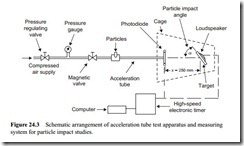Test rigs and data sources
Little data is available on the degradation of materials in pneumatic conveying sys- tems. This is partly due to the complexity of obtaining and analysing the data, but mainly to the fact that so many variables are involved, together with the problem of relating the data from one material and situation to another. A particular problem with data obtained from a pneumatic conveying system pipeline is that it is very difficult to separate the individual contributions made by the bends and the straight pipeline. A further problem is that in a pipeline there is a gradual expansion of the conveying air, which means that the particle velocity is constantly changing. Velocity is a major variable in particle degradation and so this makes attempts at analysis almost impossible.
The major source of information is probably from the basic research that has been undertaken with small bench scale test rigs in which particles have been impacted against test materials under controlled conditions. This work has often been carried out to assist in an understanding of erosive wear problems and to investigate problems of comminution. Although much of this work cannot be related directly to pneumatic conveying situations, it can provide valuable information of a comparative nature on a number of the variables in the process.
24.1.3.1 Acceleration tube device
Test facilities employed are very similar to those used in erosive wear research, such as whirling arm and acceleration tube devices. A device used by Salman et al [2] and reported by the author is shown in Figure 24.3 and consists of a linear air gun. One particle was tested at a time. Compressed air was used to accelerate the particles, and particle velocity could be varied by adjusting the air pressure. A cage was used to col- lect the particles and fragments after impact. The particle impact velocity was deter- mined by measuring the time required for a particle to travel from the end of the barrel
to the target. A photodiode was located at the end of the barrel and a loudspeaker was mounted behind the target.
In order to study the particle degradation process, brittle materials were used to ensure that no plastic deformation should take place. Three types of particle were used and tested. These were aluminium oxide, polystyrene and glass, and all the particles were spherical. The majority of the work was carried out with 5 mm diameter aluminium oxide particles, with particle velocities up to about 30 m/s. Much of the information reported here on the influence of conveying parameters is derived from this programme of work. For every test, 100 particles were impacted, and the number of unbroken particles was counted to provide an assessment of the degradation.
